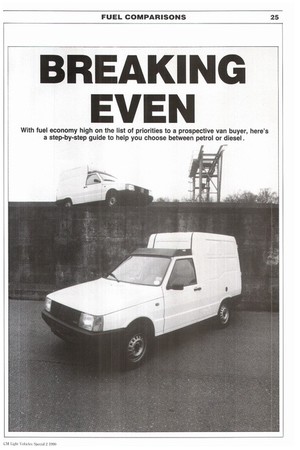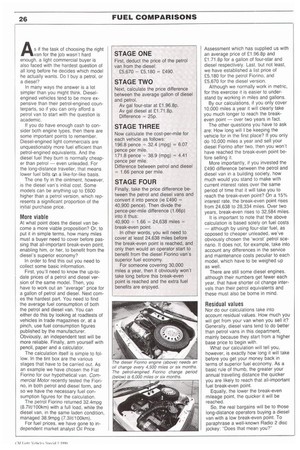REAKING EVEN
Page 109

Page 110

If you've noticed an error in this article please click here to report it so we can fix it.
With fuel economy high on the list of priorities to a prospective van buyer, here's a step-by-step guide to help you choose between petrol or diesel.
As if the task of choosing the right van for the job wasn't hard enough, a light commercial buyer is also faced with the hardest question of all long before he decides which model he actually wants. Do I buy a petrol, or a diesel?
In many ways the answer is a lot simpler than you might think. Dieselengined vehicles tend to be more expensive than their petrol-engined counterparts, so if you can only afford a petrol van to start with the question is academic.
If you do have enough cash to consider both engine types. then there are some important points to remember. Diesel-engined light commercials are unquestionably more fuel efficient than petrol-engined equivalents. And the diesel fuel they burn is normally cheaper than petrol — even unleaded. For the long-distance traveller, that means lower fuel bills on a like-for-like basis.
The one fly in the ointment, however, is the diesel van's initial cost. Some models can be anything up to £600 higher than a petrol version, which represents a significant proportion of the initial purchase price.
More viable
At what point does the diesel van become a more viable proposition? Or, to put it in simple terms, how many miles must a buyer need to cover before passing that all-important break-even point, enabling him, or her, to benefit from the diesel's superior economy?
In order to find this out you need to collect some basic information.
First, you'll need to know the up-todate prices of a petrol and diesel version of the same model. Then, you have to work out an "average" price for a gallon of petrol and diesel. Next comes the hardest part. You need to find the average fuel consumption of both the petrol and diesel van. You can either do this by looking at roadtests of vehicles in trade magazines or, at a pinch, use fuel consumption figures published by the manufacturer. Obviously, an independent test will be more reliable. Finally, arm yourself with pencil, paper and a calculator.
The calculation itself is simple to follow. In the tint box are the various stages that have to be carried out. As an example we have chosen the Fiat Fiorino for our hypothetical van. Commercial Motor recently tested the Fiorino, in both petrol and diesel form, and so we have the necessary fuel consumption figures for the calculation.
The petrol Fiorino returned 32.4mpg (8.71it/100km) with a full load, while the diesel van, in the same laden condition, managed 38.9mpg (7.3Iiti1 00km).
For fuel prices, we have gone to independent market analyst Oil Price Assessment which has supplied us with an average price of E1 96.8p and £1.71.8p for a gallon of four-star and diesel respectively. Last. but not least. we have established a list price of £5,180 for the petrol Fiorino. and £5,670 for the diesel version.
Although we normally work in metric, for this exercise it is easier to understand by working in miles and gallons.
By our calculations, if you only cover 10,000 miles a year it will clearly take you much longer to reach the breakeven point — over two years in fact.
The other questions you have to ask are: How long will I be keeping the vehicle for in the first place? If you only do 10,000 miles a year and sell your diesel Fiorino after two, then you won't have reached the break-even point before selling it.
More importantly, if you invested the £490 difference between the petrol and diesel van in a building society, how much would you stand to make with current interest rates over the same period of time that it will take you to reach the break-even point? On a 15% interest rate, the break-even point rises from 24,638 to 28,334 miles. Over two years, break-even rises to 32,584 miles.
It is important to note that the above calculation is based solely on fuel costs — although by using four-star fuel, as opposed to cheaper unleaded, we've obviously chosen the 'worst' petrol scenario. It does not, for example, take into account any differences in the service and maintenance costs peculiar to each model, which have to be weighed up as well.
There are still some diesel engines, although their numbers get fewer each year, that have shorter oil change intervals than their petrol equivalents and these must also be borne in mind.
Residual values
Nor do our calculations take into account residual values. How much you will get from your van when you sell it? Generally, diesel vans tend to do better than petrol vans in this department, mainly because they start from a higher base price to begin with.
What our calculation will tell you, however, is exactly how long it will take before you get your money back in terms of superior fuel economy. As a basic rule of thumb, the greater your annual travelling distance the quicker you are likely to reach that all-important fuel break-even point.
Equally, the lower the break-even mileage point, the quicker it will be reached.
So, the real bargains will be to those long-distance operators buying a diesel van with a low break-even point. To paraphrase a well-known Radio 2 disc jockey: "Does that mean you?"
















































































































